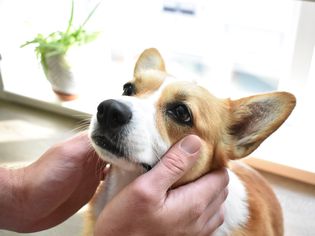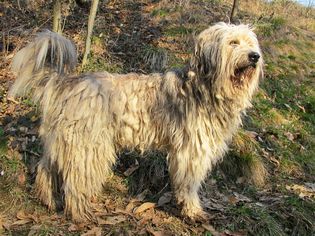Whether your dog is trying to sucker you into giving them a piece of Halloween candy or they took a nosedive into your kid’s trick-or-treat basket while you weren't looking, you may be wondering: can dogs eat Halloween candy? Unfortunately, Halloween candy isn’t considered safe for dogs.
Here's why dogs should never eat Halloween candy and how to keep your pooch safe throughout spooky season.
Dangers of Halloween Candy for Dogs
Halloween candy not only lacks nutritional value for your dog, but it can also contain dangerous ingredients and cause several health problems for your pup.
Toxic Ingredients
The following are ingredients commonly found in Halloween candy that are toxic to dogs and can be fatal if ingested.
- Chocolate: Can cause gastrointestinal illness, abnormal heart rhythms, and seizures.
- Xylitol: Can cause a severe drop in blood sugar and the development of liver failure.
- Raisins: Can cause kidney failure.
Additional Risks
Here are some additional risks that hit home why dogs should never eat Halloween candy.
- Gastrointestinal issues: Because Halloween candy is (hopefully) not a regular part of your dog’s diet, it can cause gastrointestinal upset. You may notice vomiting, diarrhea, and decreased appetite in your dog even if the candy they consumed didn't contain any toxic ingredients.
- Too much sugar: Halloween candy also contains a lot of sugar. While this isn't good for any dog, it could be particularly dangerous for dogs with diabetes.
- Obstruction or blockage: Lastly, the wrappers on the candy can lead to digestive issues. These wrappers can ball together and cause an obstruction in the stomach or intestines. They can also cause irritation that may result in vomiting, diarrhea, and poor appetite. While wrappers will usually pass on their own given enough time, your dog can require surgery to remove a severe obstruction.
Symptoms of Candy Poisoning in Dogs
If your dog happens to consume Halloween candy, monitor them for the following symptoms:
- Vomiting
- Diarrhea
- Reduced appetite
- Abdominal pain
- Lethargy
- Restlessness
- Excessive thirst
- Excessive urination
- Panting
- Seizures
What to Do if Your Dog Eats Halloween Candy
If your dog eats Halloween candy, it’s best to seek help immediately rather than wait for symptoms to develop. If your dog has ingested something toxic, they are more likely to have a positive outcome if the issue is addressed as soon as possible.
Here's what to do if your dog eats Halloween candy:
- Remove access to the candy. This will prevent your pet from consuming more and keep your other pets safe while you determine if your dog needs medical attention.
- Identify what your dog ate, if possible. Having access to the label or wrapper will allow you to provide helpful information to a veterinarian.
- Contact your veterinarian. If it is after hours, contact an emergency veterinarian. The ER veterinarian will usually let you know if there is a need for medical attention. You should especially contact a veterinarian right away especially if your dog has ingested chocolate (especially dark or baking chocolate), raisins, or anything with the sugar substitute xylitol.
- Contact animal poison control, such as the ASPCA’s Poison Control or the Pet Poison Helpline. Consultation fees may apply.
Warning
Do not induce vomiting unless directed to do so by your veterinarian. It is safer for your veterinarian to induce vomiting if necessary.
Dog-Safe Alternatives to Halloween Candy
Your dog can enjoy Halloween without eating candy. Here are a few popular alternatives to share with your pet this Halloween so they don't feel left out.
Seasonal Dog Treats
A lot of pet stores and pet bakeries will make pet-safe Halloween treats. You may also be able to find a dog-safe Halloween treat recipe online that you can make yourself.
Dog-Safe Fruits
If you really want to give your dog something sweet, consider feeding them one of these dog-safe fruits:
- Strawberries
- Apples
- Bananas
- Blueberries
Just make sure to remove any stems, peels, seeds, and cores before giving fruit to your dog.
Regular Dog Treats
And you can always spoil your dog with some regular dog treats! But keep in mind that calories from treats should never make up more than 10% of your dog's total daily caloric intake.
How to Keep Your Dog Safe This Hallowen
Prevention is key when it comes to protecting your pets. The following tips will help keep your dog safe during Halloween:
- Keep candy out of reach. This means putting candy in a safe and secure location, such as high up in a pantry or a closed drawer. Dogs can easily get into bags, baskets, and purses if left unattended.
- Avoid buying toxic Halloween candy, such as dark chocolate, candies that contain xylitol, and anything with raisins to hand out to trick-or-treaters on the holiday.
- If you or your kids receive candies with one of these three toxins we have mentioned, consider taking the candy to work or school to keep pets safe at home.
- If your pet comes with you to trick-or-treat, make sure they aren't being snuck toxic treats by trick-or-treaters who may not know better. Also, you'll want to watch for candy that’s been dropped on the ground.
- After you're done enjoying Halloween candy, make sure candy wrappers are thrown away in a closed and latching trash can.
Preventing your pet from getting into Halloween candy is the best way to protect them, but it doesn't hurt to have a plan in place if your dog does accidentally eat Halloween candy (or any other toxic food). Anticipate your pup's tricks, and only give them dog-safe treats!








